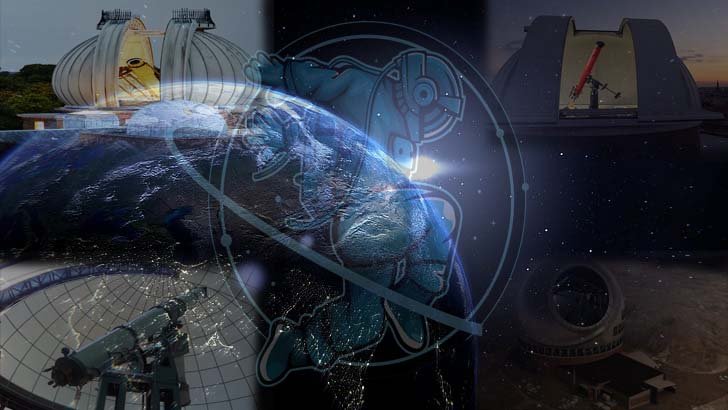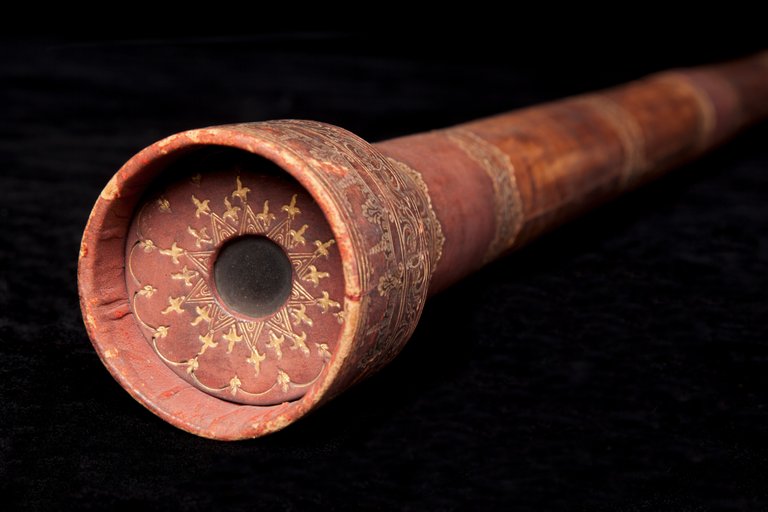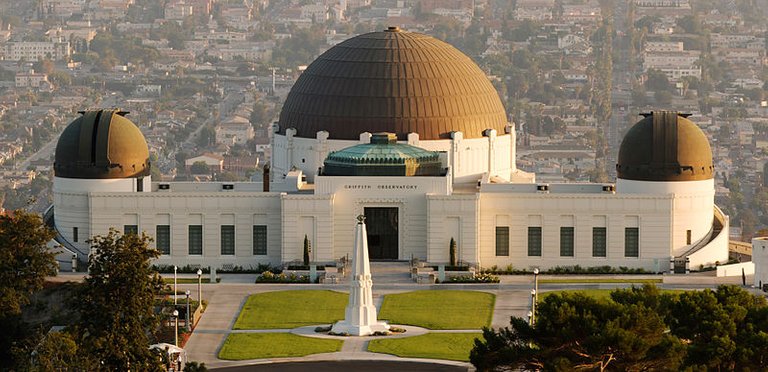A look at the infinite universe: Earth observatories

Una mirada al infinito universo: Observatorios terrestres
¡Hola, hola, colmena! Continuamos con el quinto capítulo, el último de la serie de Astronomía, donde nos dimos como objetivo el estudio en toda dimensión de esta hermosa y apasionante ciencia.
En el capítulo anterior, abordamos el tema de cómo la humanidad ha logrado rebasar la barrera de la atmósfera y sumergirse en el espacio mediante la creacion de sondas.
Ahora bien, desde hace más 400 años la humanidad intentó estudiar esos fenómenos desde la misma Tierra, utilizando observatorios terrestres. La historia del observatorio se remonta a la antigüedad, cuando los seres humanos comenzaron a observar el cielo y a estudiar los movimientos de los cuerpos celestes. Sin embargo, la idea de un observatorio dedicado a la astronomía científica moderna no surgió sino hasta el siglo XVII, cuando se construyeron los primeros telescopios según la historia tradicional.

Ocular de un telescopio galileano. Créditos: Alessandro Nassiri / Museo Nazionale della Scienza e della Tecnologia Leonardo da Vinc
Uno de los primeros observatorios modernos fue el Observatorio de Greenwich, fundado en 1657 en Inglaterra por el rey Carlos II para ayudar a los navegantes a determinar la longitud en el mar, una necesidad importante en la época de los grandes viajes de exploración. Hoy en día cuenta con un telescopio refractor fabricado por la compañía Merz Múnich en 1859, el cual pesa aproximadamente 90 kilogramos, además de otras importantes actualizaciones y remodelaciones.

Observatório de Greenwich. Créditos: National Maritime Museum
Los observatorios modernos son instalaciones especializadas equipadas con tecnología de última generación para la observación del universo. Estos observatorios se utilizan para estudiar diversos objetos celestes, como estrellas, planetas, galaxias, nebulosas y agujeros negros. Algunos de los observatorios modernos más conocidos son el Observatorio Europeo Austral (ESO), el Observatorio W. M. Keck en Hawái y el Observatorio del Roque de los Muchachos en las Islas Canarias.
Muchos de estos observatorios también están disponibles para que los científicos y el público en general puedan utilizarlos para la investigación y la educación.
El Observatorio Europeo Austral (ESO), una organización compuesta por 15 países miembros; Austria, Bélgica, República Checa, Dinamarca, Finlandia, Francia, Alemania, Italia, Holanda, Polonia, Portugal, España, Suecia, Suiza y Reino Unido y Chile como país anfitrión.
Cuenta con cuatro divisiones en sus observadores, en el cual resalta el observatorio La Silla el cual se encuesta en Santiago, a 600 kilómetros de la capital de Chile. Cuenta con un telescopio ESO de 3.6 metros de espejo principal, posee al rastreador de planetas extrasolares más importante del mundo: el instrumento HARPS (High Accuracy Radial velocity Planet Searcher o Buscador de Planetas con Velocidad Radial de Alta Precisión) un espectrógrafo con una envidiable precisión.

El observatorio La Silla
El Observatorio W. M. Keck en Hawái cuenta con los telescopios Keck I y II, los cuales se ubican como los terceros más grandes de mundo. Tienen 10 metros de diámetro de espejos segmentados, con un peso total alrededor de 300 toneladas. Está ubicado en la cima del volcan inactivo de Hawai Mauna Kea. Con total de inversión de 140 millones de dólares inició su funcionamiento en 1993.
Gracias a su potente y especial óptica, pudo detallar ciertas órbitas de estrellas que giran al rededor del objeto denominado Sagitario A, el cual mediante el estudio exhaustivo se supo que era un agujero negro supermasivo de 4 millones de masas solares. Como producto a tal hallazgo la Física Andrea Ghez responsable del estudio fue galardonada, junto a otros, con el premio Nobel de Física del 2020.

El Observatorio Keck W. H. en Hawái
El Observatorio del Roque de los Muchachos (ORM) es un observatorio astronómico ubicado en la isla de La Palma, en las Islas Canarias (España). Está situado a una altitud de 2.396 metros sobre el nivel del mar, lo que lo convierte en uno de los mejores lugares del mundo para la observación astronómica debido a su clima estable y cielos despejados.
El ORM cuenta con varios telescopios e instrumentos científicos, algunos de los cuales son propiedad de varios países y organizaciones internacionales. El telescopio más grande del observatorio es el Gran Telescopio CANARIAS (GTC), que es uno de los telescopios ópticos más grandes del mundo. El ORM también cuenta con otros telescopios ópticos y telescopios de radio, así como instrumentos especializados para estudiar la atmósfera terrestre y los objetos celestes.
El Observatorio del Roque de los Muchachos es operado por el Instituto de Astrofísica de Canarias (IAC) y es uno de los observatorios más importantes del mundo para la investigación astronómica. Los científicos que trabajan en el ORM estudian una amplia gama de temas, como la formación de estrellas y planetas, la evolución de galaxias, la estructura del universo y la búsqueda de vida extraterrestre. Además, el observatorio también está abierto al público para visitas guiadas y eventos educativos.

El Observatorio del Roque de los Muchachos (ORM)
Los observatorios modernos tienen muchas ventajas, entre ellas:
Tecnología avanzada: los observatorios modernos cuentan con tecnología avanzada que permite la observación del universo con mayor precisión y detalle que nunca antes. Los instrumentos de detección, las cámaras y los telescopios modernos permiten la captura de imágenes de alta calidad y resolución, lo que permite a los científicos estudiar objetos celestes con gran detalle.
Accesibilidad remota: muchos observatorios modernos se pueden controlar y operar de forma remota, lo que permite a los científicos acceder a ellos desde cualquier lugar del mundo. Esto significa que los investigadores pueden realizar observaciones sin tener que estar físicamente en el observatorio, lo que aumenta la eficiencia y reduce los costos.

El Observatorio Griffith ubicado en Los Ángeles
Colaboración internacional: muchos observatorios modernos son proyectos internacionales, lo que significa que científicos de todo el mundo pueden colaborar en investigaciones conjuntas. Esto permite la combinación de recursos y conocimientos para lograr avances significativos en la comprensión del universo.
Estudio de objetos celestes lejanos: los observatorios modernos pueden observar objetos celestes muy lejanos, lo que permite a los científicos estudiar galaxias, estrellas y planetas que de otra manera serían inaccesibles. Esto ha permitido importantes descubrimientos, como la identificación de exoplanetas y la detección de ondas gravitacionales.
Educación y divulgación: muchos observatorios modernos están abiertos al público y ofrecen programas educativos y de divulgación científica. Esto permite a las personas de todas las edades aprender sobre astronomía y la exploración del universo, lo que puede fomentar el interés y la curiosidad por la ciencia en general.
Con esto damos por culminado la serie de Astronomía, donde tuve como objetivo informar sobre esta hermosa ciencia que día a día toma más importancia en el proceso evolutivo de la humanidad.
Espero les haya gustado, mi gente. Hasta la próxima entrega.
Fuente de las imágenes:
Imagen 1: Autoría propia. Realizada con base en imágenes libres.
Imagen 2: Fuente
Imagen 3: Fuente
Imagen 4: Fuente
Imagen 5: Fuente
Imagen 6: Fuente
Imagen 7: Fuente
Imagen 8: Fuente
Imagen 9: Fuente
Fuentes de consulta:
- https://www.elmundo.es/elmundo/2009/03/18/ciencia/1237369385.html
- https://opcc.cl/ESO.html
- https://keckobservatory.org/about/telescopes-instrumentation/
- https://www.iac.es/es/observatorios-de-canarias/observatorio-del-roque-de-los-muchachos
- https://osr.org/es/blog/astronomia-es/observatorios-mas-importantes-del-mundo-donde-se-encuentran/
English Version

A look at the infinite universe: Earth observatories
Hello, hello, hive! We continue with the fifth chapter, the last of the Astronomy series, where we set ourselves the objective of studying this beautiful and exciting science in all dimensions.
In the previous chapter, we addressed the issue of how humanity has managed to overcome the barrier of the atmosphere and plunge into space through the creation of probes.
Now, for more than 400 years humanity tried to study these phenomena from Earth itself, using terrestrial observatories. The history of the observatory dates back to ancient times, when human beings began to observe the sky and study the movements of celestial bodies. However, the idea of an observatory dedicated to modern scientific astronomy did not emerge until the 17th century, when the first telescopes were built according to the traditional story.

Eyepiece of a Galilean telescope. Credits: Alessandro Nassiri / Museo Nazionale della Scienza e della Tecnologia Leonardo da Vinc
One of the first modern observatories was the Greenwich Observatory, founded in 1657 in England by King Charles II to help navigators determine longitude at sea, an important necessity in the age of great voyages of exploration. Today it has a refracting telescope manufactured by the Merz Munich company in 1859, which weighs approximately 90 kilograms, in addition to other important updates and remodeling.

Greenwich Observatory. Credits: National Maritime Museum
Modern observatories are specialized facilities equipped with the latest technology for observing the universe. These observatories are used to study various celestial objects, such as stars, planets, galaxies, nebulae, and black holes. Some of the best-known modern observatories are the European Southern Observatory (ESO), the W. M. Keck Observatory in Hawaii and the Roque de los Muchachos Observatory in the Canary Islands.
Many of these observatories are also available for use by scientists and the general public for research and education.
The European Southern Observatory (ESO), an organization made up of 15 member countries; Austria, Belgium, the Czech Republic, Denmark, Finland, France, Germany, Italy, the Netherlands, Poland, Portugal, Spain, Sweden, Switzerland and the United Kingdom and Chile as the host country.
It has four divisions in its observers, in which the La Silla observatory stands out, which is surveyed in Santiago, 600 kilometers from the capital of Chile. It has an ESO telescope with a 3.6-meter main mirror, it has the most important extrasolar planet tracker in the world: the HARPS instrument (High Accuracy Radial velocity Planet Searcher) a spectrograph with enviable precision.

La Silla Observatory
The W. M. Keck Observatory in Hawaii houses the Keck I and II telescopes, which rank as the third largest in the world. They have 10 meter diameter segmented mirrors, with a total weight of about 300 tons. It is located on top of the dormant Hawaiian volcano Mauna Kea. With a total investment of 140 million dollars, it began operations in 1993.
Thanks to his powerful and special optics, he was able to detail certain orbits of stars that revolve around the object called Sagittarius A, which through exhaustive study was found to be a supermassive black hole of 4 million masses. solar. As a result of this finding, the Physicist Andrea Ghez responsible for the study was awarded, along with others, the 2020 Nobel Prize in Physics.

The Keck W.H. Observatory in Hawaii
The Roque de los Muchachos Observatory (ORM) is an astronomical observatory located on the island of La Palma, in the Canary Islands (Spain). It is situated at an altitude of 2,396 meters above sea level, making it one of the best places in the world for astronomical observation due to its stable climate and clear skies.
The ORM has several telescopes and scientific instruments, some of which are owned by various countries and international organizations. The observatory's largest telescope is the Gran Telescopio CANARIAS (GTC), which is one of the largest optical telescopes in the world. The ORM also has other optical telescopes and radio telescopes, as well as specialized instruments for studying the Earth's atmosphere and celestial objects.
The Roque de los Muchachos Observatory is operated by the Instituto de Astrofísica de Canarias (IAC) and is one of the most important observatories in the world for astronomical research. Scientists working at the ORM study a wide range of topics, including star and planet formation, galaxy evolution, the structure of the universe, and the search for extraterrestrial life. In addition, the observatory is also open to the public for guided tours and educational events.

The Roque de los Muchachos Observatory (ORM)
Modern observatories have many advantages, including:
Advanced Technology: Modern observatories feature advanced technology that allows observation of the universe with greater precision and detail than ever before. Modern detection instruments, cameras, and telescopes enable the capture of high-quality, high-resolution images, allowing scientists to study celestial objects in great detail.
Remote Accessibility: Many modern observatories can be controlled and operated remotely, allowing scientists to access them from anywhere in the world. This means that researchers can make observations without having to physically be at the observatory, increasing efficiency and reducing costs.

The Griffith Observatory located in Los Angeles
International Collaboration: Many modern observatories are international projects, meaning scientists from around the world can collaborate on joint research. This allows the combination of resources and knowledge to achieve significant advances in the understanding of the universe.
Study of Faraway Celestial Objects: Modern observatories can observe very distant celestial objects, allowing scientists to study otherwise inaccessible galaxies, stars, and planets. This has allowed important discoveries, such as the identification of exoplanets and the detection of gravitational waves.
Education and Outreach: Many modern observatories are open to the public and offer educational and science outreach programs. This allows people of all ages to learn about astronomy and exploring the universe, which can foster interest and curiosity in science in general.
With this we conclude the Astronomy series, where I had the objective of reporting on this beautiful science that day by day takes on more importance in the evolutionary process of humanity.
I hope you liked it, my people. Until the next installment.
Source of images:
Image 1: Own authorship. Made based on free images.
Image 2: Fuente
Image 3: Fuente
Image 4: Fuente
Image 5: Fuente
Image 6: Fuente
Image 7: Fuente
Image 8: Fuente
Image 9: Fuente
Reference sources:
- https://www.elmundo.es/elmundo/2009/03/18/ciencia/1237369385.html
- https://opcc.cl/ESO.html
- https://keckobservatory.org/about/telescopes-instrumentation/
- https://www.iac.es/es/observatorios-de-canarias/observatorio-del-roque-de-los-muchachos
- https://osr.org/es/blog/astronomia-es/observatorios-mas-importantes-del-mundo-donde-se-encuentran/
Congratulations @jrevilla! You have completed the following achievement on the Hive blockchain And have been rewarded with New badge(s)
Your next target is to reach 4750 upvotes.
You can view your badges on your board and compare yourself to others in the Ranking
If you no longer want to receive notifications, reply to this comment with the word
STOPCheck out our last posts:
Support the HiveBuzz project. Vote for our proposal!
Thanks for your contribution to the STEMsocial community. Feel free to join us on discord to get to know the rest of us!
Please consider delegating to the @stemsocial account (85% of the curation rewards are returned).
You may also include @stemsocial as a beneficiary of the rewards of this post to get a stronger support.
¡Felicitaciones!
1. Invierte en el PROYECTO ENTROPÍA y recibe ganancias semanalmente. Entra aquí para más información.
3. Suscríbete a nuestra COMUNIDAD, apoya al trail de @Entropia y así podrás ganar recompensas de curación de forma automática. Entra aquí para más información sobre nuestro trail.
4. Creación de cuentas nuevas de Hive aquí.
5. Visita nuestro canal de Youtube.
Atentamente
El equipo de curación del PROYECTO ENTROPÍA
¡Enhorabuena!
✅ Has hecho un buen trabajo, por lo cual tu publicación ha sido valorada y ha recibido el apoyo de parte de CHESS BROTHERS ♔ 💪
♟ Te invitamos a usar nuestra etiqueta #chessbrothers y a que aprendas más sobre nosotros.
♟♟ También puedes contactarnos en nuestro servidor de Discord y promocionar allí tus publicaciones.
♟♟♟ Considera unirte a nuestro trail de curación para que trabajemos en equipo y recibas recompensas automáticamente.
♞♟ Echa un vistazo a nuestra cuenta @chessbrotherspro para que te informes sobre el proceso de curación llevado a diario por nuestro equipo.
🏅 Si quieres obtener ganancias con tu delegacion de HP y apoyar a nuestro proyecto, te invitamos a unirte al plan Master Investor. Aquí puedes aprender cómo hacerlo.
Cordialmente
El equipo de CHESS BROTHERS